Schenker-Joyau SAS Bundle
What's Next for Schenker-Joyau SAS After the DSV Acquisition?
The logistics world is abuzz following DSV's acquisition of DB Schenker, a move that reshapes the industry landscape. This pivotal shift, finalized in April 2025, places Schenker-Joyau SAS at the forefront of a new era. Understanding the Schenker-Joyau SAS SWOT Analysis is crucial to grasp the company's future prospects.
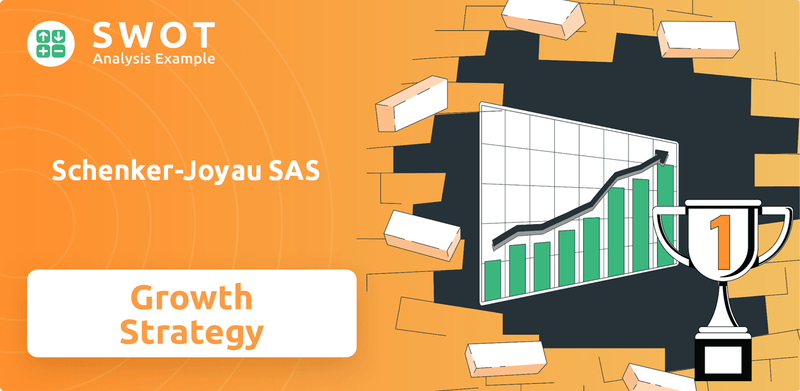
This acquisition presents both exciting opportunities and significant challenges for Schenker-Joyau SAS. The company's future growth strategy will be intrinsically tied to DSV's broader strategic planning and business development initiatives. We will delve into the market analysis, strategic planning, and long-term growth projections of Schenker-Joyau SAS, examining how it intends to navigate the evolving demands of the global supply chain.
How Is Schenker-Joyau SAS Expanding Its Reach?
The acquisition of DB Schenker by DSV represents a significant expansion initiative, fundamentally reshaping the logistics landscape. This merger is a pivotal element of the overall Growth Strategy for the combined entity, aiming to create a leading player in the global transport and logistics sector. The strategic move is designed to enhance service offerings and broaden the geographical footprint, providing greater value to customers worldwide.
The integration of DB Schenker into DSV is expected to generate substantial synergies. DSV's track record in integrating acquired companies, such as Panalpina in 2019 and Agility's GIL arm in 2021, underscores its capability to manage large-scale integrations effectively. This strategic approach is crucial for realizing the full potential of the acquisition and achieving the projected financial benefits.
The integration of DB Schenker is projected to yield annual synergies, estimated at DKK 9.0 billion (approximately EUR 1.2 billion) by the end of 2028. These synergies will primarily stem from streamlining operations, consolidating logistics facilities in Road and Solutions, and optimizing back-office functions, finance, and IT infrastructure. DSV's commitment to investing approximately €1 billion in Germany over the next three to five years further highlights its dedication to expanding and optimizing operations in key regions. This investment underscores the Company Future Prospects and its commitment to long-term growth.
DSV's Growth Strategy heavily relies on strategic acquisitions. The acquisition of DB Schenker is the largest in DSV's history, significantly increasing its market share and global presence. This strategy has proven successful in the past, with previous acquisitions contributing to substantial revenue and operational growth.
The integration of DB Schenker is designed to create significant operational synergies. These synergies will be achieved through the consolidation of logistics facilities, streamlining back-office functions, and optimizing IT infrastructure. The goal is to reduce costs and improve efficiency across the combined operations.
DSV plans to invest approximately €1 billion in Germany over the next three to five years. This investment demonstrates a commitment to expanding and optimizing operations in key markets. The focus is on enhancing infrastructure and improving service capabilities to support long-term growth.
DB Schenker has implemented innovative solutions to improve efficiency. The new warehouse in Rudna, Czech Republic, utilizes autonomous mobile robots (AMRs) and automated sorting systems. These technological advancements enhance operational speed and accuracy, providing better service to customers.
Prior to the acquisition, DB Schenker showcased expansion through various initiatives. For instance, the establishment of a new warehouse in Rudna, Czech Republic, which incorporates over 100 autonomous mobile robots (AMR), seven packaging lines, and an automatic sorting system. Furthermore, the introduction of a new standardized onboard courier (OBC) service for urgent, high-value consignments, expanded its portfolio of specialized logistics solutions. These developments highlight the focus on leveraging advanced logistics infrastructure and specialized services to expand market reach and cater to diverse customer needs. For more insights into the company's values, consider reading about the Mission, Vision & Core Values of Schenker-Joyau SAS.
The Growth Strategy of Schenker-Joyau SAS involves several key elements. These include strategic acquisitions, operational synergies, and significant investments in key regions. These strategies are designed to enhance market share and improve service capabilities, ensuring a strong Company Future Prospects.
- Strategic Acquisitions: DSV's acquisition strategy is a cornerstone of its growth, with DB Schenker being a prime example.
- Operational Synergies: The integration of acquired companies aims to streamline operations and reduce costs.
- Investment in Key Regions: Significant investments, such as the €1 billion planned for Germany, support expansion.
- Technological Advancements: Implementing advanced technologies, like AMRs, enhances efficiency and service quality.
Schenker-Joyau SAS SWOT Analysis
- Complete SWOT Breakdown
- Fully Customizable
- Editable in Excel & Word
- Professional Formatting
- Investor-Ready Format
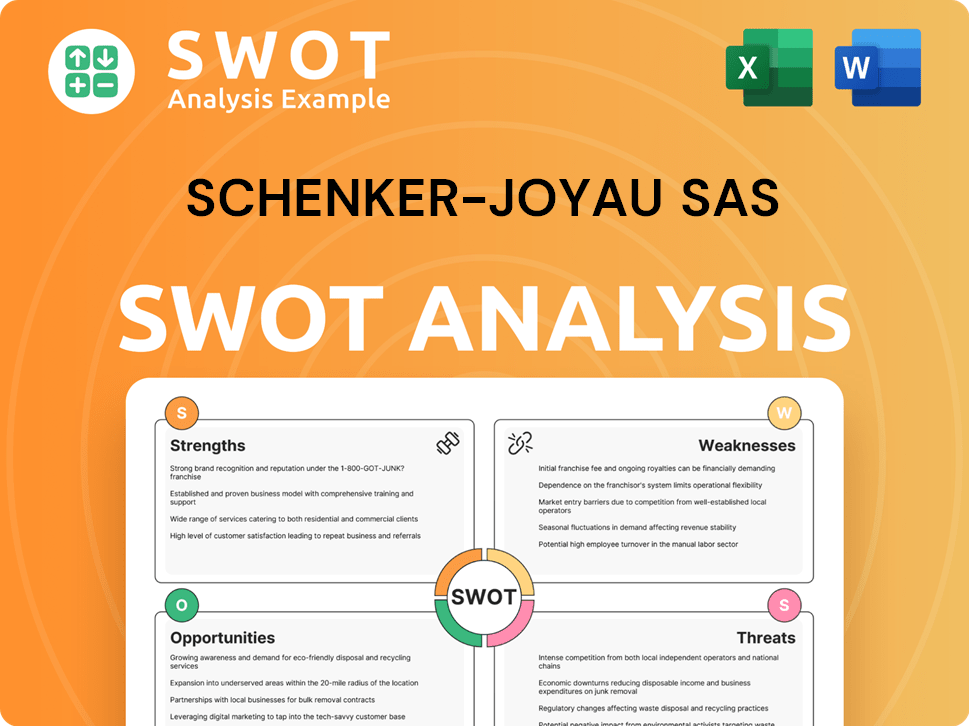
How Does Schenker-Joyau SAS Invest in Innovation?
The focus on innovation and technology at DB Schenker-Joyau SAS, now part of DSV, is crucial for its Growth Strategy and future in the logistics industry. This approach enables the company to meet evolving customer needs and preferences in a dynamic market. By integrating cutting-edge technologies, DB Schenker-Joyau SAS aims to improve operational efficiency and provide superior service, which is essential for maintaining a competitive edge.
Customers increasingly demand real-time visibility, efficient solutions, and sustainable practices. DB Schenker-Joyau SAS responds to these demands by investing in digital transformation and sustainable logistics solutions. This commitment helps the company not only meet current market needs but also anticipate future trends, ensuring its long-term success and relevance in the global market.
The company's Business Development is significantly influenced by its technological advancements and sustainability efforts. These strategic initiatives are designed to enhance customer satisfaction and drive operational excellence. By focusing on these areas, DB Schenker-Joyau SAS aims to strengthen its market position and achieve its strategic goals.
DB Schenker-Joyau SAS is actively pursuing digital transformation to enhance its services and operations. This includes the implementation of advanced tools and systems to improve efficiency and customer experience. The company's focus on digital solutions is a key component of its Strategic Planning.
In 2024, DB Schenker introduced 'Ocean Bridge,' an AI-driven supply chain monitoring tool. This tool provides real-time insights into ocean freight cargo, enhancing visibility and control. 'Ocean Bridge' uses telematic data and algorithms, including AIS positions, to create reliable predictive schedules.
DB Schenker-Joyau SAS invests in automation and robotics to optimize its logistics operations. This includes the deployment of autonomous mobile robots (AMRs) and automated sorting systems in warehouses. The new warehouse in Rudna, Czech Republic, exemplifies this commitment.
The company is testing chatbots to enhance customer support. These chatbots allow customers to track freight, get rate quotes, and request pick-up shipments. This initiative aims to improve customer service and streamline interactions.
Sustainability is a core part of DB Schenker-Joyau SAS's innovation strategy. The company aims to become carbon neutral and is developing sustainable logistics solutions. This includes complying with regulations like the EU's Corporate Sustainability Reporting Directive (CSRD) which began in 2024.
DB Schenker-Joyau SAS collaborates with other companies to advance its sustainability goals. An example is the partnership with Microsoft Cloud Logistics, which aims to facilitate low-carbon intercontinental transportation. These collaborations support the company's Company Future Prospects.
DB Schenker-Joyau SAS's approach to innovation and technology is multifaceted, focusing on digital solutions, automation, and sustainability. These strategies are designed to enhance operational efficiency, improve customer service, and meet the growing demand for sustainable logistics solutions. The company's investments in these areas are crucial for its long-term growth and competitiveness. For a deeper understanding of the competitive environment, consider exploring the Competitors Landscape of Schenker-Joyau SAS.
- Digitalization: Implementing AI-driven tools like 'Ocean Bridge' for real-time cargo tracking and predictive scheduling.
- Automation: Utilizing AMRs and automated sorting systems in warehouses to improve efficiency and speed. The new warehouse in Rudna, Czech Republic, is a prime example.
- Sustainability: Focusing on carbon neutrality and developing sustainable logistics solutions, including collaborations with partners like Microsoft.
- Customer Service: Testing chatbots to provide instant support for freight tracking, rate quotes, and shipment requests.
- Compliance: Adhering to regulations such as the EU's CSRD, which began in 2024, to ensure environmental responsibility.
Schenker-Joyau SAS PESTLE Analysis
- Covers All 6 PESTLE Categories
- No Research Needed – Save Hours of Work
- Built by Experts, Trusted by Consultants
- Instant Download, Ready to Use
- 100% Editable, Fully Customizable
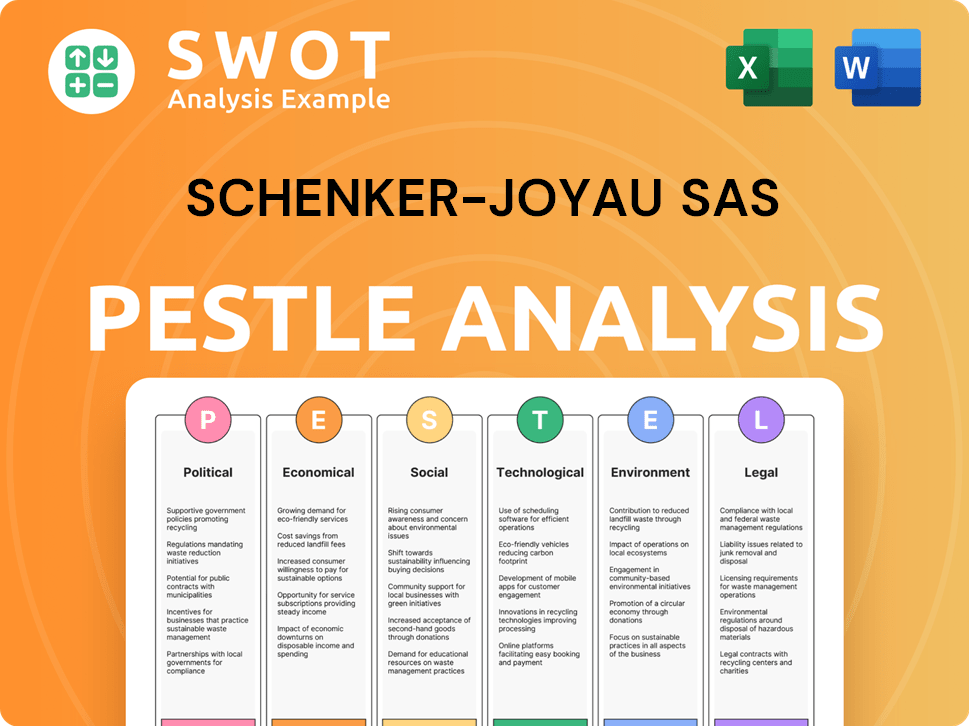
What Is Schenker-Joyau SAS’s Growth Forecast?
The financial outlook for Schenker-Joyau SAS, now part of DSV, is significantly shaped by the acquisition finalized on April 30, 2025. This acquisition, valued at €14.3 billion, has positioned DSV as the world's largest logistics company. This strategic move is crucial for understanding the Growth Strategy and Company Future Prospects of the combined entity.
DSV's acquisition of Schenker-Joyau SAS is poised to reshape the logistics landscape. With the integration of Schenker-Joyau SAS, DSV's pro-forma revenue is approximately €40.3 billion, supported by a workforce of around 160,000 employees across more than 90 countries, based on 2024 financials. This expansion is a key element of the Business Development strategy.
Prior to the acquisition, Schenker-Joyau SAS demonstrated strong financial performance in 2024, with revenue of €19.2 billion and an adjusted operating profit (EBIT) of €1.1 billion. This profitability was a key driver for the acquisition. For further insights into the ownership structure and related financial aspects, you can refer to Owners & Shareholders of Schenker-Joyau SAS.
DSV aims to achieve annual synergies of DKK 9.0 billion (approximately EUR 1.2 billion) by the end of 2028. These synergies are expected to come from the integration of Schenker-Joyau SAS into DSV's operations. This will involve streamlining processes and leveraging the combined resources of both companies.
The acquisition is projected to be EPS accretive (diluted and adjusted) by 2026. This indicates that the acquisition is expected to increase earnings per share for DSV shareholders. This financial outcome is a key indicator of the success of the Strategic Planning.
DSV intends to lift the operating margins of the combined entity to a minimum of DSV's levels within the respective business areas by 2028. This will involve improving operational efficiency and integrating the two companies. This is a critical component of the Market Analysis.
To finance the acquisition, DSV raised approximately DKK 75.0 billion (EUR 10.0 billion) through equity and bond issuances in October 2024. The remaining financing was covered by cash and existing credit facilities. This financial strategy is crucial for the Schenker-Joyau SAS financial performance and outlook.
DSV targets an unchanged capital structure, with a financial gearing ratio of net interest-bearing debt, including leasing liabilities, below 2.0x EBITDA before special items, although the pro-forma ratio was expected to be around 3.0x at the completion of the transaction. Deutsche Bahn, the former parent company, will use the proceeds from the sale to reduce its net financial debt, which stood at €32.6 billion at the end of 2024.
- Deutsche Bahn aims to reduce its net debt to between €26 billion and €28 billion by 2027.
- This debt reduction strategy is intended to strengthen Deutsche Bahn's financial position.
- The sale of Schenker-Joyau SAS is a key part of Deutsche Bahn's efforts to deleverage.
- DSV's financial strategy will influence the Schenker-Joyau SAS market share and trends.
Schenker-Joyau SAS Business Model Canvas
- Complete 9-Block Business Model Canvas
- Effortlessly Communicate Your Business Strategy
- Investor-Ready BMC Format
- 100% Editable and Customizable
- Clear and Structured Layout
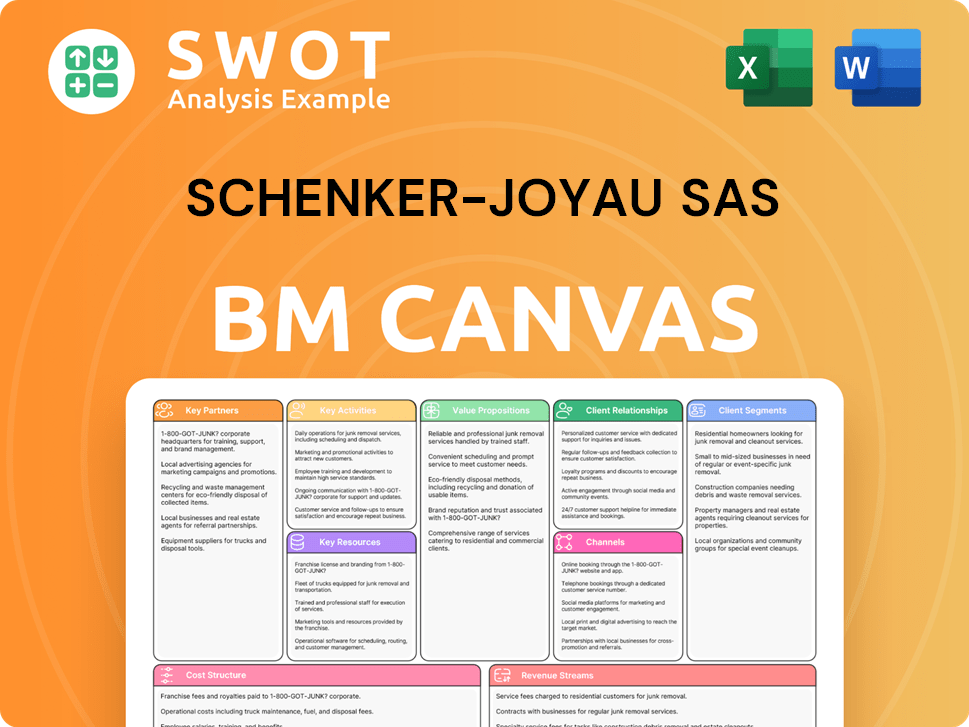
What Risks Could Slow Schenker-Joyau SAS’s Growth?
The integration of DB Schenker into DSV presents significant risks for the combined entity's Growth Strategy and future ambitions. A major challenge lies in effectively integrating Schenker's extensive operations, which include approximately 71,100 employees across more than 1,850 locations in over 130 countries. This requires consolidating operations, logistics facilities, and IT infrastructure to achieve the projected DKK 9.0 billion in annual synergies by 2028.
Market competition remains a constant threat in the dynamic logistics industry. The combined DSV-Schenker entity will face intense competition from other major logistics providers. Regulatory changes and geopolitical uncertainties, such as those impacting global trade routes, can lead to disruptions, increased freight rates, and altered trade patterns, directly affecting profitability and operational efficiency. For example, the year 2024 saw significant geopolitical shifts and global elections in 76 countries, introducing instability that can impact shipping rates.
Supply chain vulnerabilities, including port congestions, strikes, and weather-related events, pose inherent risks in the logistics sector, potentially causing delays and unexpected costs. Technological disruption also presents a risk if the company fails to keep pace with advancements in areas like AI, automation, and digitalization. Furthermore, internal resource constraints, particularly in talent acquisition and retention, could hinder growth.
Successfully integrating Schenker's vast operations is a complex undertaking, requiring careful management of diverse business functions across multiple locations. DSV must consolidate operations, logistics facilities, and IT infrastructure to realize the projected synergies.
The logistics industry is highly competitive, with numerous global players vying for market share. The combined entity will face continuous pressure from competitors, necessitating strategic agility and efficient operations.
Geopolitical events and regulatory changes can disrupt global trade routes and impact freight rates. The instability caused by global elections and other events can directly affect profitability and operational efficiency. You can find more information about this in the Target Market of Schenker-Joyau SAS.
Supply chain disruptions, such as port congestions, strikes, and weather events, can cause significant delays and unexpected costs. These factors can undermine operational efficiency and profitability.
Failing to keep pace with advancements in AI, automation, and digitalization poses a risk. Rapid technological changes require continuous investment and adaptation to maintain a competitive edge.
The logistics industry faces a demand for qualified and committed employees. Internal resource constraints, particularly in talent acquisition and retention, could hinder growth and operational effectiveness.
Schenker-Joyau SAS Porter's Five Forces Analysis
- Covers All 5 Competitive Forces in Detail
- Structured for Consultants, Students, and Founders
- 100% Editable in Microsoft Word & Excel
- Instant Digital Download – Use Immediately
- Compatible with Mac & PC – Fully Unlocked
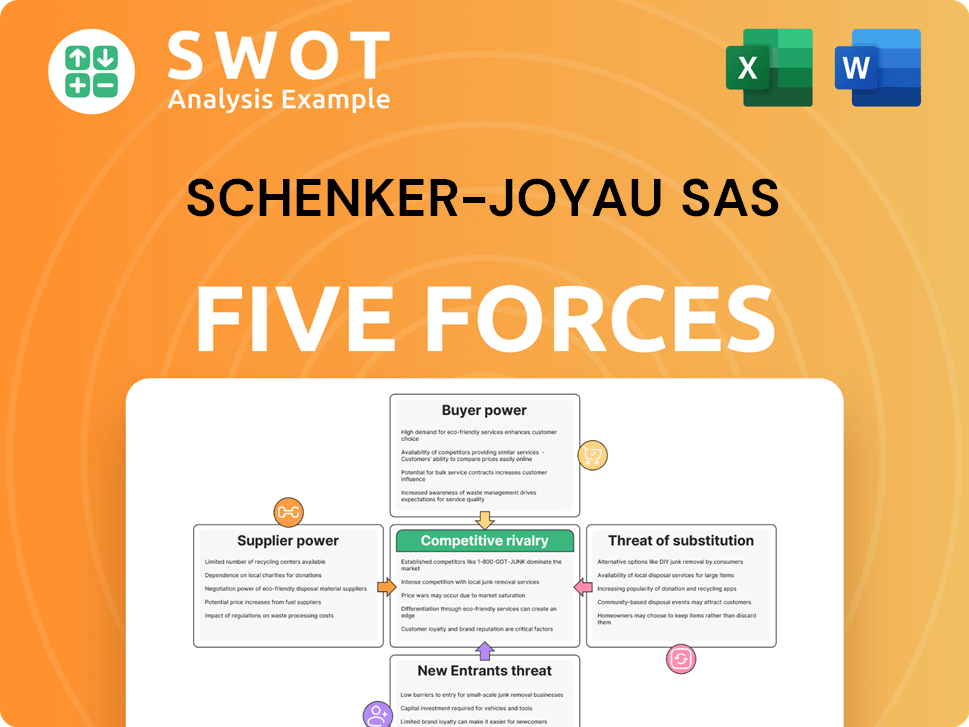
Related Blogs
- What are Mission Vision & Core Values of Schenker-Joyau SAS Company?
- What is Competitive Landscape of Schenker-Joyau SAS Company?
- How Does Schenker-Joyau SAS Company Work?
- What is Sales and Marketing Strategy of Schenker-Joyau SAS Company?
- What is Brief History of Schenker-Joyau SAS Company?
- Who Owns Schenker-Joyau SAS Company?
- What is Customer Demographics and Target Market of Schenker-Joyau SAS Company?
Disclaimer
All information, articles, and product details provided on this website are for general informational and educational purposes only. We do not claim any ownership over, nor do we intend to infringe upon, any trademarks, copyrights, logos, brand names, or other intellectual property mentioned or depicted on this site. Such intellectual property remains the property of its respective owners, and any references here are made solely for identification or informational purposes, without implying any affiliation, endorsement, or partnership.
We make no representations or warranties, express or implied, regarding the accuracy, completeness, or suitability of any content or products presented. Nothing on this website should be construed as legal, tax, investment, financial, medical, or other professional advice. In addition, no part of this site—including articles or product references—constitutes a solicitation, recommendation, endorsement, advertisement, or offer to buy or sell any securities, franchises, or other financial instruments, particularly in jurisdictions where such activity would be unlawful.
All content is of a general nature and may not address the specific circumstances of any individual or entity. It is not a substitute for professional advice or services. Any actions you take based on the information provided here are strictly at your own risk. You accept full responsibility for any decisions or outcomes arising from your use of this website and agree to release us from any liability in connection with your use of, or reliance upon, the content or products found herein.